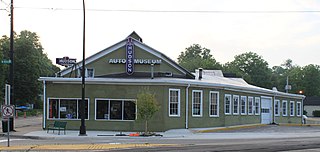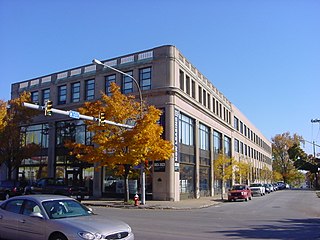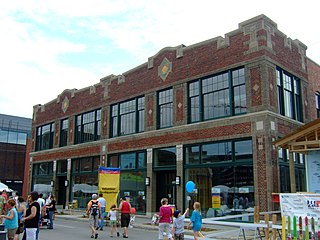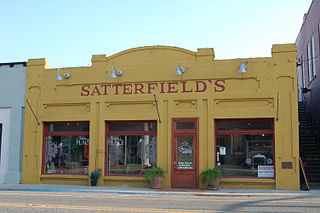
The REO Motor Car Company was a company based in Lansing, Michigan, which produced automobiles and trucks from 1905 to 1975. At one point, the company also manufactured buses on its truck platforms.
Colman Park is a 24.3-acre (98,000 m2) park in the Mount Baker neighborhood of Seattle, Washington, located just south of the Lacey V. Murrow Memorial Bridge along Lake Washington and inland to 31st Avenue S.

The Ypsilanti Automotive Heritage Museum in Ypsilanti, Michigan is an automotive museum that features cars assembled at the nearby Willow Run Plant and vehicles made by Hudson Motors. The museum is an official site of the MotorCities National Heritage Area, which is "dedicated to preserving, interpreting and promoting the automotive and labor heritage of the State of Michigan."

The H Street Playhouse was a black box theater and gallery located in the Atlas District, in Northeast Washington D.C. Home to resident companies Scena Theatre, Theater Alliance and Forum Theatre, the Playhouse also hosted African Continuum Theatre Company, Musefire, Landless Theater Company, Theater Blue, Journeymen Theater Company, Madcap Players, Solas Nua, Restoration Stage, Capitol Renaissance Theatre, and Barnstormers. After opening its doors in 2001, the H Street Playhouse, with Theater Alliance, was at the forefront of a movement to develop and revitalize the H Street commercial corridor. The H Street Playhouse closed in 2012.

The New Amsterdam Historic District is a historic district located in Detroit, Michigan. Buildings in this district are on or near three sequential east-west streets on the two blocks between Woodward Avenue and Second Avenue. It was listed on the National Register of Historic Places in 2001.

The Reo Motor Car Company Plant was an automotive manufacturing factory, built for the REO Motor Car Company, located at 2100 South Washington Street Lansing, Michigan. It was designated a National Historic Landmark (NHL) and listed on the National Register of Historic Places (NRHP) in 1978, but completely demolished by the beginning of 1980. It was delisted from the NRHP in 1986.

Packard Motor Car Showroom and Storage Facility is a historic automobile showroom located at Buffalo in Erie County, New York. It is a three-story, reinforced concrete frame structure with restrained Neo-classical detailing. It was designed by Albert Kahn in about 1926 and served as a Packard dealership for 30 years.

The Young Brothers Chevrolet Garage is a site on the National Register of Historic Places located in Chinook, Montana. It has also been known as AAA Garage, as Taylor Motor Company, as Tilleman Chevrolet, and as Precision Auto Body. It was added to the Register on August 16, 1994. It is a stucco building with an asphalt roof.

The D.S. Chamberlain Building, also known as the L. W. Taylor Motor Company and Payne Motor Company Building, is a historic building located in Des Moines, Iowa, United States. The two-story brick structure was designed by the prominent Des Moines architectural firm of Proudfoot, Bird & Rawson. Completed in 1917, it features elongated Chicago-style windows on the upper floors and simple geometric details on the cornice level that reflect the Collegiate Gothic style. The building was built as a speculative venture by Davis S. Chamberlain, who was one of the founders of his family's drug manufacturing company. It is located in the city's "Motor Row" or "Auto Row" on the west side of downtown. In 1916 there were 111 motor related firms in Des Moines that was valued at $12 million in annual trade. Both the Taylor Motor Company and the Payne Motor Company were housed in the double storefront building for many years. Other car dealerships followed. The building was listed on the National Register of Historic Places in 2007.

The Packard Motor Car Company Building, also known as the Press Building, is a historic office building located at 317–321 N. Broad Street between Pearl and Wood Streets in the Callowhill neighborhood of Philadelphia, Pennsylvania. The structure was built in 1910–11 and was designed by Albert Kahn of the noted Detroit architectural firm of Kahn & Wilby. It is a seven-story, steel framed, reinforced concrete building – one of the first uses of that material in a commercial building. Clad in terra cotta and featuring an ornamented canopy and a prominent overhanging roof, the building housed a showroom and new car inventory space for the Packard Motor Car Company. The showroom was remodeled in 1927 by Philip Tyre. In November 1928, the building became the headquarters of the Philadelphia Record newspaper, which it remained until the Record folded in a 1947 strike.

Salem Avenue–Roanoke Automotive Commercial Historic District is a national historic district located of Roanoke, Virginia. It encompasses 59 contributing buildings in the southwestern part of the City of Roanoke. The district includes a variety of buildings having automotive, warehouse, light industrial and residential uses. Most of the buildings are small-scale, one or two-story brick or concrete block buildings, with the majority built between about 1920 and 1954. Notable buildings include the former Enfield Buick Dealership, Lindsay-Robinson & Co. Building (1918), Fulton Motor Company Auto Sales & Service (1928), Lacy Edgerton Motor Company, Roanoke Motor Car Company, and Fire Department No. 3 (1909).

The Ford Motor Company - Columbus Assembly Plant is a historic building in Downtown Columbus, Ohio. The Ford plant was constructed in 1914, to designs by John Graham. The plant operated until 1939. In later years, it became the Kroger Co. Columbus Bakery, operating until 2019. The building was sold in 2020, and is planned to be redeveloped into a large residential complex, announced in 2021. The building was added to the National Register of Historic Places and Columbus Register of Historic Properties in 2021.

The Apperson Iowa Motor Car Company Building, also known as the Garage Building for Rawson Brothers, is a historic building located in Des Moines, Iowa, United States. It is significant for its association with the prominent Des Moines architectural firm that designed it, Proudfoot, Bird & Rawson. Completed in 1921, it was designed and built within the period of time the firm was at its most prolific (1910-1925). It is also significant for its association with the rise of the Automobile Industry in the city. Auto dealerships and distributorships leased the building from 1921 to 1951. Architect Harry D. Rawson and his brothers owned the building from 1921 to 1938. The two-story structure is located on a midblock lot in the midst of what was the automobile sales, service, and manufacturing district on the western edge of the downtown area. The first floor housed a showroom in the front with offices on a mezzanine. The back of the first floor and the second floor was used for assembling and servicing automobiles. The building was listed on the National Register of Historic Places in 2016.

The Studebaker Corporation Branch Office Building, also known as the Iowa Truck and Tractor Co., Apperson Iowa Motor Car Co., Sears Auto Co., and the Sanders Motor Co., is a historic building located in Des Moines, Iowa, United States. This is actually two adjacent buildings, built four years apart. The building at 1442 Locust Street was completed in 1918 to house a Studebaker dealership, auto repair shop, and a corporate branch office. The addition of the corporate office made this building different from the others on Des Moines' "Auto Row," where it is located. The building was designed by the prominent local architectural firm of Proudfoot, Bird & Rawson, and built for the Hubbell Building Company who leased it out. The first floor was the location for Glass & Patton, the local Studebaker dealer. The second floor was where Studebaker's wholesale business in the state of Iowa was conducted. The third floor was a store room for automobiles. Studebaker's tenure here was short-lived, and by 1919 other auto and truck related businesses started to occupy the building.

The Aztec Motor Company Building, at 301 S. Main in Aztec, New Mexico, was built around 1906. It was listed on the National Register of Historic Places in 1985.

The Davenport Motor Row and Industrial Historic District is a nationally recognized historic district located on the eastern edge of downtown Davenport, Iowa, United States. It was listed on the National Register of Historic Places in 2019. At the time of its nomination it consisted of 28 resources, which included 21 contributing buildings, one contributing site, one contributing structure, and five non-contributing buildings. The area was previously a part of the notorious Bucktown, a district of saloons, beer gardens, brothels, billiard parlors, gambling establishments, and theaters. Davenport licensed prostitution in 1893, gambling in 1904, and failed to enforce Iowa prohibition laws during this period. A crusade against vice by Davenport's Catholic bishop, Henry Cosgrove, and reforms by state leaders led to the district's transformation in the early 20th century into a light industrial area. The city's automobile industry settled here beginning in the 1910s. They stayed until the mid-20th century when Interstate 80 was completed on the north side of the city and they moved to the suburban areas. U.S. Route 32 and its successor U.S. Route 6 passed through the district on East Second Street from 1926 to 1937. The Government Bridge (1896), which for years was the city's only bridge across the Mississippi River, is immediately adjacent to the district.

The Eldridge Building is a historic building in Spokane, Washington. It was designed by architect Gustav Albin Pehrson, and built in 1925. It has been listed on the National Register of Historic Places (NRHP) since November 12, 1992. It is one of three historic buildings listed on the NRHP at the intersection of First Avenue and Cedar Street. To the west across Cedar is the Grand Coulee building and to the northwest, kitty-corner from the Eldridge Building, is the former Carnegie Library.

The Greater Columbus Arts Council (GCAC) is an arts organization in Columbus, Ohio. The council funds artists and organizations in Central Ohio, and hosts the annual Columbus Arts Festival.
Mount Baker Park is a 21.7-acre (8.8 ha) urban park in Seattle, Washington, United States. It is located along a ravine in the Mount Baker neighborhood in the Rainier Valley, stretching from South McClellan Street in the south to Lake Washington Boulevard at its north end. The park's north end is adjacent to Mount Baker Beach on Lake Washington and Colman Park. The south end connects to Mount Baker Boulevard, a scenic street that continues southwest to Franklin High School and the Mount Baker light rail station.

Satterfield Motor Company Building is a single-story commercial building at 108 E. Main Street, New Roads, Louisiana. The building was built in 1918 and backs onto the False River. It was listed on the National Register of Historic Places in 1994.





















